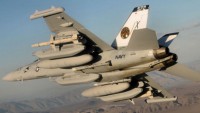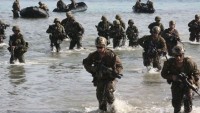China Silent in Face of Massive US Navy Show of Force in South China Sea
| Arthur Dominic Villasanta | | Jul 07, 2016 06:36 PM EDT |
(Photo : US Navy) A US Navy FA-18 Super Hornet lifts off from the USS John C. Stennis
China's outgunned navy and air force have been conspicuously absent in the face of a huge show of force by the U.S. Navy in the South China Sea.
This massive increase in U.S. Navy hardware comes ahead of the July 12 decision by an international tribunal that will in all likelihood rule against China's claim to own most of the South China Sea. The Philippines sued China before the international Permanent Court of Arbitration in The Hague after China's 2012 seizure of Scarborough Shoal, which is located within the Philippines' 200-mile exclusive economic zone.
Like Us on Facebook
In the latest challenge to China, three Navy guided missile destroyers have been "quietly stalking some of China's man-made islands and claims in recent weeks" in advance of the international tribunal ruling, according to sources cited by the Navy Times.
Now patrolling the South China Sea and the Scarborough Shoal, a feature owned by the Philippines but seized by China, are the destroyers USS Spruance (DDG-111), USS Stethem (DDG-63) and USS Momsen (DDG-92). The three additional destroyers bring with them over 200 vertical launch systems capable of firing hundreds of anti-ship and surface-to-air missiles.
Over the past two weeks, these ships have all patrolled near Chinese-claimed features at Scarborough Shoal and in the Spratly Islands, according to officials at the U.S. Department of Defense. These destroyers "have been regularly patrolling within the 14 to 20 nautical mile range of these features."
The Spruance and Momsen, which belong to the U.S. Navy Third Fleet's Pacific Surface Action Group, began their patrols in April. The Stethem is part of Destroyer Squadron 15 of the U.S. Navy Seventh Fleet.
Both fleets, which have separate carrier battle groups built around a Nimitz-class supercarrier, have been patrolling the South China Sea and adjoining waters since June to deter a Chinese attack against the Philippines.
"I anticipate that China will take additional actions after the Hague tribunal, and I think there is a desire to show that after that happens there is not going to be a ramp-up of U.S. forces in the region: that they are already there," said Jerry Hendrix, an analyst with the Center for a New American Security, a non-partisan think-tank based in Washington D.C.
"The Navy is trying to very strongly assert freedom of navigation and freedom of the seas. There is also, I think, some anticipation of The Hague's ruling on China's claims."
The two carrier strike groups in these carriers consist of 140 aircraft, including 80 F/A-18 Hornets that can either engage in air-to-air combat or can attack naval targets such as warships of the outgunned People's Liberation Army Navy.
The battle group of the supercarrier USS John C. Stennis includes the Aegis cruiser USS Mobile Bay and guided missile destroyers USS William P. Lawrence, USS Chung-Hoon and USS Stockdale.
The battle group of the USS Ronald Reagan includes the Aegis cruiser USS Chancellorsville and guided-missile destroyers USS Curtis Wilbur, USS McCampbell and USS Benfold.
Arrayed against the U.S. Navy are the PLAN's East Sea Fleet and South Sea Fleet that together can muster 16 destroyers, 40 frigates and 28 diesel submarines. The PLAN has no operational aircraft carrier, which means its surface forces will be outmatched by the two U.S. Navy carriers groups patrolling the South China Sea should a naval war ensue.
China announced naval exercises from July 5 to 11 in the South China Sea but around the Paracel Islands it controls but not in the Spratlys and Scarborough Shoal where the US Navy is patrolling.
TagsU.S. Navy, South China Sea, Philippines, Permanent Court of Arbitration in The Hague, Scarborough Shoal, U.S. Navy Third Fleet, U.S. Navy Seventh Fleet
©2015 Chinatopix All rights reserved. Do not reproduce without permission
EDITOR'S PICKS
-

Did the Trump administration just announce plans for a trade war with ‘hostile’ China and Russia?
-

US Senate passes Taiwan travel bill slammed by China
-

As Yan Sihong’s family grieves, here are other Chinese students who went missing abroad. Some have never been found
-

Beijing blasts Western critics who ‘smear China’ with the term sharp power
-

China Envoy Seeks to Defuse Tensions With U.S. as a Trade War Brews
-

Singapore's Deputy PM Provides Bitcoin Vote of Confidence Amid China's Blanket Bans
-

China warns investors over risks in overseas virtual currency trading
-

Chinese government most trustworthy: survey
-

Kashima Antlers On Course For Back-To-Back Titles
MOST POPULAR
LATEST NEWS
Zhou Yongkang: China's Former Security Chief Sentenced to Life in Prison

China's former Chief of the Ministry of Public Security, Zhou Yongkang, has been given a life sentence after he was found guilty of abusing his office, bribery and deliberately ... Full Article
TRENDING STORY

China Pork Prices Expected to Stabilize As The Supplies Recover

Elephone P9000 Smartphone is now on Sale on Amazon India

There's a Big Chance Cliffhangers Won't Still Be Resolved When Grey's Anatomy Season 13 Returns

Supreme Court Ruled on Samsung vs Apple Dispute for Patent Infringement

Microsoft Surface Pro 5 Rumors and Release Date: What is the Latest?













